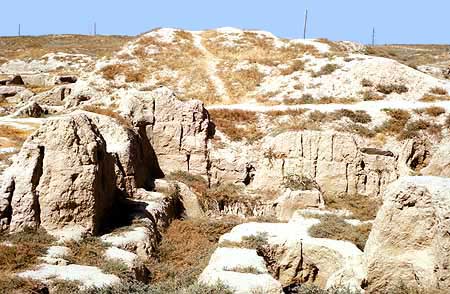
| Court art of Sogdian Samarqand in the 7th century AD | |||||||||||||
| Home | General | Western Wall | Northern Wall | Eastern Wall | Southern Wall | Bibliography | |||||||
 |
|
|||||||||||||||||||||||||||||||||||||||||||
 Archaeology in the landscapes of ancient Sogd has furnished us with a great amount of works of art, mainly from the early Middle Ages. Of highest value are the
wall paintings from a palace hall (object 23, room 1) of the Sogdian ruler Varxuman at Samarqand (Afrasiab
site). Their importance can be seen in several peculiarities, among them quality and measure of the remains, furthermore their wealth in accessories and the existence of inscriptions. Today the paintings from four walls, each one eleven meters long, are rearranged in a special museum building at Samarqand's Afrasiab site - and so they may be visited as if in their original position.
Archaeology in the landscapes of ancient Sogd has furnished us with a great amount of works of art, mainly from the early Middle Ages. Of highest value are the
wall paintings from a palace hall (object 23, room 1) of the Sogdian ruler Varxuman at Samarqand (Afrasiab
site). Their importance can be seen in several peculiarities, among them quality and measure of the remains, furthermore their wealth in accessories and the existence of inscriptions. Today the paintings from four walls, each one eleven meters long, are rearranged in a special museum building at Samarqand's Afrasiab site - and so they may be visited as if in their original position.
There is hardly a publication on pre-Islamic Central Asian art or cultural history without some mention or an image of these paintings. On the other hand very few serious studies discuss the contents of the paintings and thus pay tribute to their uniqueness and delicacy (cp. bibliography).
In 1993 the author of these web pages has published the following study:
| Mode, Markus: Sogdien und die Herrscher der Welt. Türken, Sasaniden und Chinesen in Historiengemälden des 7. Jahrhunderts n. Chr. aus Alt-Samarqand [= Europäische Hochschulschriften. Reihe XXVII. Kunstgeschichte, Bd. 162] - Frankfurt a.M. (a.o.) 1 |
One year after my 1993 publication about the murals from the palace of Varxuman, the most important expert on Sogdian art, Boris Ilyich Maršak, presented his own interpretation in a lengthy and well-grounded article [1994]. His study is the full version of a lecture he had given already in 1990 on the same conference at Samarqand where I have had the privilege to speek on this topic, too. The abstract of Maršak's lecture I took into consideration in my 1993 publication, and Maršak on his part replied - to some extent - in his article of 1994. Meanwhile, other scholars have enriched the discussions. At this point I only mention Yutaka Yoshida's comments and additions on Nicholas Sims-Williams study about Sogdian merchants in China. In a footnote we read the conclusive opinion of Yoshida that my "...whole interpretation of the wall painting of Afrasiab will need extensive revision" [Yoshida 1996]. That's all - and with this we are as wise as before.
In 1999, a magnificent handbook on Central Asian art appeared in France: "Les arts de l'Asie centrale", written under the direction of P. Chuvin. A very useful gazetteer towards the end of the book contains a paragraph on Sogdian Samarqand, where the recent French excavations are mentioned, as well as the famous paintings from Varxuman's palace. Right beyond the text one can see a small partial reconstruction of the paintings. This reconstruction contains certain errors, although parts seem to be based on one of my own published sketches. And, to add further news, a French scientific group has started to save and restore the original paintings, as we learn from a web-publication at afrasiab.org., where first insights are given together with an overall reconstruction of the murals from the southern wall. The drawing deserves special attention and we will mention its weak points later.
Over the past ten years we observed the forthgoing discussion. It may be concluded that there are - in the whole - no overwhelming efforts during this timespan. Therefore, and because my 1993 publication was written in German, I decided to repeat my main theses for a broader public - and the best way to do so is to make use of the web. At minor points I have slightly modified some arguments - but the main course of interpretation remains unchanged: At present I cannot see a serious weakening of it.
Certainly, any final interpretation of the paintings is difficult. But the new publications and activities just mentioned have caused us to insist once more on these magnificent Sogdian paintings.
As well as with my 1993 publication, these web pages do not attempt to give an overall presentation of the Afrasiab murals. Instead we invite the interested visitor to follow through some of the main argumentative points and ideas developed more than ten years ago. They are concentrated on (but not restricted to) the central question for a date of the murals. B. I. Maršak [2001] placed them at about AD 660 (elsewhere even later). We will try to show that this is at least ten years too late...
1 Cp. reviews in East and West 43, 1993, pp. 334-335 [M. Taddei]; Wiener Zeitschrift für die Kunde des Morgenlandes 83, 1993, pp. 283-284 [B. Brentjes]; Hephaistos 14, 1996, pp. 279-284 [D. Metzler]
 |
|
|||||||||||||||||||||||||||||||||||||||||||